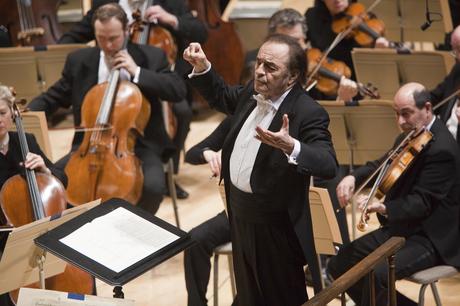
Charles Dutoit conducts the Boston Symphony Orchestra.
Photo by Michael J. Lutch © 2010 Boston Symphony Orchestra.
Mr. Dutoit brought that experience and skill with Berlioz to Thursday night's concert at Symphony Hall. Roméo et Juliette is a sprawling six-movement "Symphonie-dramatique", that combines orchestra, chorus, and solo singers to transform Shakespeare's tragedy into a narrative told largely by the orchestra. The work, consisting of both vocal and instrumental movements, was challenging when Berlioz wrote it in 1839. It remains among his more difficult pieces to bring off in a live performance.
Berlioz' decision to set Shakespeare as a symphony was triggered in 1827, when he attended an English performance of the Bard's works in Paris, featuring one Harriet Smithson. Roméo represents Berlioz himself, smitten with Juliette/Ms. Smithson, who the composer later married and divorced. The Irish actress was also featured as the love-interest in Berlioz' earlier exercise in genre-busting, the Symphonie-fantastique.
Under Mr. Dutoit, the six movements coalesced into a fluent, cohesive whole with a firm sense of dramatic arc. The BSO strings responded well to his direction in the first movement, alternating with loud brass chords to depict street fights between the Montagues and Capulets. The small chorus, accompanying mezzo-soprano Bernarda Fink set the stage for the battle between the families and the meeting of the young lovers.
It is a mark of Berlioz' innovative spirit that the lovers are not represented by singers--only by figurations within the orchestra. The vocal solos are reserved for the Narrator (Ms. Fink), Roméo's buddy Mercutio (Jean-Paul Fouchécourt) and Father Laurence (Laurent Naouri). Mr. Fouchécourt made the Queen Mab aria an exercise in fluent French tenor style, producing beautiful tone as he skipped above the sprightly accompaniment the rambling six-movement adaptation of Shakespeare's tragedy into a fluent, cohesive whole.
In the next three (mostly) instrumental movements, the orchestra depicts Roméo at the ball, the following balcony scene, and the characters' eventual demise within the tomb of the Capulets. There is also the famous "Queen Mab" scherzo, which expands upon the material of Mercutio's aria to produce fairy music worthy of Mendelssohn. Mr. Dutoit led these movements with senstitivity and sympathy for the star-crossed protagonists, and the Boston forces responded with orchestral playing of the highest caliber.
The full Tanglewood Festival Chorus marched onto the stage for Juliette's funeral procession. The most powerful music in the symphony, the funeral march was played with real weight. In the finale, Mr. Naouri brought gravitas to the role of Father Laurence. As he admonished the assembled Montagues and Capulets, Mr. Naouri sang with smoky, dark tone, cutting through and over the massed orchestral and choral forces behind him.
Berlioz ends the tragedy on a note of reconciliation and an oath of friendship between the families. This has nothing to do with Shakespeare but serves to brings his most massive symphony to an upward, almost triumphant close. After the tumult of the 2010-2011 season, the Boston players sounded as if the reconciliation was very welcome indeed.

